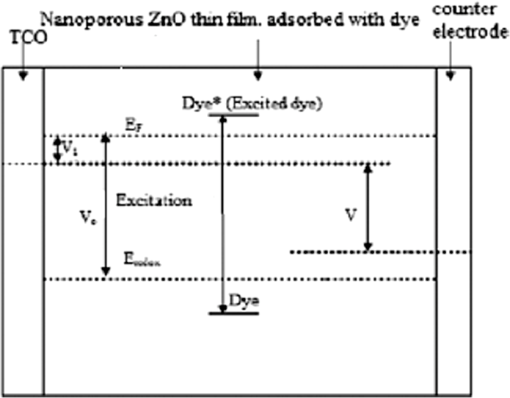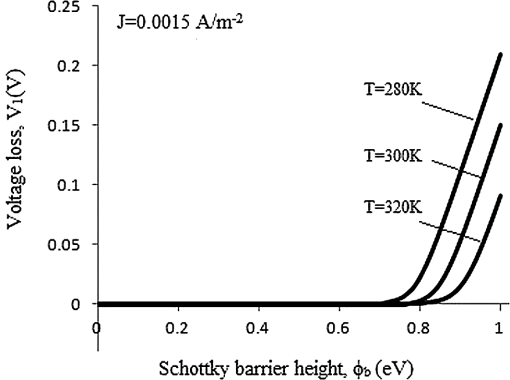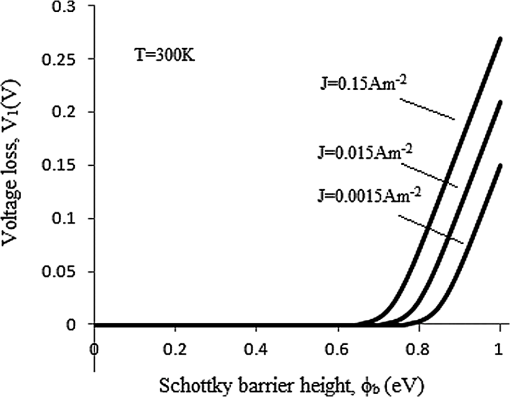|
|
1.IntroductionDye-sensitized solar cells (DSC) are basically photo electrochemical solar cells that are currently being subject to intense research in the framework of renewable energies as low cost photovoltaic devices. The DSC is composed of photoactive electrode, which is generally made of mesoporous, nanostructured metal oxide film (, ZnO, , etc). The photoelectrode is sensitized to visible light by adsorbing a molecular dye. When the photon is absorbed, dye gets to the excited state. This leads to the injection of electrons into the metal oxide substrate. The injected electrons move through the nanostructured film to the transparent conducting oxide (TCO). The electron donor in the electrolyte solution regenerates the dye, which in turn gets regenerated by accepting the electron coming from the counter electrode. The power conversion efficiency of the DSC has reached up to 11.5%.1 The movement of electrons through nanostructured network is a complicated process because of the large surface-area-to-volume ratio of the concerned nanomaterial. Efficient electron injection from excited dye to nanostructured metal oxide film plays a crucial role in the performance of DSC.2,3 The injected electron gets transported through nanostructured film mainly due to diffusion.4,5 The transport kinetics of flow of injected electrons is influenced by the incident intensity and trapping-detrapping mechanism.6,7 The electric potential distribution plays a vital role in the functioning of dye-sensitized solar cells. Ruhle et al. proposed a model based on a built-in electric field and the possibility of a Schottky barrier at the interface of the mesoporous semiconductor () and the TCO (usually -doped tin oxide, FTO).8 Kron et al. investigated the influence of front contact barrier by using different front contact materials to the nanoporous layer.9 Most of the research in DSC has been centered on as a nanostructured film as a photo electrode. The best-suited alternative material to is ZnO,10–12 which has a similar band gap (3.2 eV) and band edge position to .13 ZnO nanoparticles and nanowires are repeatedly used to fabricate DSC electrodes.14,15 Branched ZnO nanowire structure has recently been used in DSC.16 In this study, a theoretical model was developed by taking a thermionic emission model into consideration and investigating the ZnO/TCO interfacial effects on the performance of DSC. TCO substrate can be considered to be metal as it is heavily doped (e.g., doped ) and has high electrical conductivity.8 A Schottky barrier model can then be used for simulation of ZnO/TCO interface.17–19 The details of theoretical modeling are discussed in the following sections. 2.Theoretical ModelingThere is a flow of injected electrons through the porous nanostructured ZnO thin film toward the TCO. Subsequently the electrons reach the counter electrode by the external circuit. There is a regeneration of oxidized dye by redox madiators followed by the transportation of the oxidized redox mediators () to the counter electrode where they are regenerated to complete the cycle. The electron density inside mesoporous layer rises with the injection of electrons in which the quasi-Fermi level () comes near to conduction band edge (). The difference between and the electrolyte redox potential is considered to be the photovoltage.20,21 However, under maximum power operating conditions the potential differences due to two interfaces should also come into the picture (i.e., photoelectrode/TCO and electrolyte/counter electrode interface). There has been various efforts to study the influence of counter electrode,22–24 but the effect of ZnO/TCO interface has not been effectively studied. Under irradiation, photo injection of electrons results in a rise in quasi-Fermi levels of ZnO and TCO as shown in Fig. 1. As the ZnO/TCO interface effect is under study, the loss of voltage due to counter electrode/electrolyte interface in not considered. The photovoltage can be rewritten as where is the potential difference between the ZnO Fermi level () and redox potential of electrolyte (), and is the voltage loss at the ZnO/TCO interface. This voltage loss, derived from the Schottky barrier height, appears at the ZnO/TCO interface, resulting in the internal resistance.Two mechanisms that control electron transfer at the interface are thermionic emission and electron tunneling as described by metal semiconductor contact theory.17,18 But electron tunneling can be neglected as ZnO is lightly doped,19,20 and cell operates at a high temperature (300 K); under such circumstances thermionic emission dominates the electron transfer. It should be mentioned here that when ZnO is heavily doped or the operating temperature is low, electron tunneling becomes significant, which minimizes the interfacial effect. It should be noted that due to small size of ZnO particles () as well as the strong screening effect of electrolyte, there is negligible macroscopic electric field in the porous ZnO thin film. Therefore, under such conditions, the proposed thermionic emission model may not be valid. However, here we treat DSC as a series connection of a Schottky diode with a certain barrier height representing the metal/-type semiconductor interface and the main diode, which corresponds with the injection of electrons from semiconductor film into the electrolyte. is the current density corresponding to the applied voltage , including the voltage loss at the ZnO/TCO interface. The following expression correlates the voltage loss at the ZnO/TCO interface with reference to thermionic emission theory.18,25 where is the effective Richardson constant equal to for ZnO, is the temperature, is the Boltzmann constant equal to and is the charge of an electron equal to . Equation (2) can be rearranged to3.Results and DiscussionAccording to Eq. (3), the voltage loss due to ZnO/TCO interface depends upon Schottky barrier height, temperature, and recombination current at the TCO/electrolyte interface. Cameron et al. estimated that the current density due to recombination of electrons with electrolyte via TCO substrate lie in the range from to (Ref. 26). Figure 2 shows the variation of with , for different values of . There exists a critical value of below . An increase in results in decrease in this critical . Taking current density to be , the theoretical analysis was done, and the result showing the effect of , on at different are plotted in Fig. 3. Again there exists a critical value of below, which is negligible. Above this critical value, increases with increase in Schottky barrier height. As temperature increases there is a rise in the critical value. It is evident that for values of , the voltage loss is negligible. It can be predicted that FTO and Al can be good candidates for TCO material. 4.ConclusionsInvestigation of ZnO/TCO interfacial effect on DSC was done on the basis of a Schottky barrier model derived from thermionic emission theory. The effect of the interface depends on the current density, temperature, and Schottky barrier height. At low Schottky barrier height, there is negligible voltage loss that leads to almost unaffected DSC performance. The interfacial effect becomes significant as the Schottky barrier height increases beyond critical value. The results are important: by considering the voltage loss at the ZnO/TCO interface, the accuracy in the prediction of characteristics of the DSC can also be improved. The modeling can be used to assist selection of appropriate TCO material for high ZnO-based DSC efficiency. ReferencesC. Chenet al.,
“Highly efficient light-harvesting ruthenium sensitizer for thin-film dye-sensitized solar cells,”
ACS Nano, 3
(10), 3103
–3109
(2009). http://dx.doi.org/10.1021/nn900756s 1936-0851 Google Scholar
G. Francoet al.,
“Frequency-resolved optical detection of photoinjected electrons in dye-sensitized nanocrystalline photovoltaic cells,”
J. Phys. Chem. B, 103
(4), 692
–698
(1999). http://dx.doi.org/10.1021/jp984060r JPCBFK 1520-6106 Google Scholar
N. J. Cherepyet al.,
“Ultrafast electron injection: implications for a photoelectrochemical cell utilizing an anthocyanin dye-sensitized nanocrystalline electrode,”
J. Phys. Chem. B, 101
(4), 9342
(1997). http://dx.doi.org/10.1021/jp972197w JPCBFK 1520-6106 Google Scholar
J. A. AntaF. CasanuevaG. Oskam,
“A numerical model for charge transport and recombination in dye-sensitized solar cells,”
J. Phys. Chem. B, 110
(11), 5372
–5378
(2006). http://dx.doi.org/10.1021/jp056493h JPCBFK 1520-6106 Google Scholar
J. Bisquertet al.,
“Physical chemical principles of photovoltaic conversion with nanoparticulate, mesoporousdye-sensitized solar cells,”
J. Phys. Chem. B, 108
(24), 8106
–8118
(2004). http://dx.doi.org/10.1021/jp0359283 JPCBFK 1520-6106 Google Scholar
L. M. PeterK. G. U. Wijayantha,
“Intensity dependence of the electron diffusion length in dye-sensitised nanocrystalline photovoltaic cells,”
Electrochem. Commun., 1
(12), 576
(1999). http://dx.doi.org/10.1016/S1388-2481(99)00120-4 ECCMF9 1388-2481 Google Scholar
K. FredinJ. NissfolkA. Hagfeldt,
“Brownian dynamics simulations of electrons and ions in mesoporous films,”
Sol. Energy Mater. Sol. Cells, 86
(2), 283
(2005). http://dx.doi.org/10.1016/j.solmat.2004.07.010 SEMCEQ 0927-0248 Google Scholar
S. RuhleD. Cahen,
“Electron tunneling at the interface can determine dye sensitized solar cell performance,”
J. Phys. Chem. B, 108
(46), 17946
–17951
(2004). http://dx.doi.org/10.1021/jp047686s JPCBFK 1520-6106 Google Scholar
G. KronU. RauJ. H. Werner,
“Influence of the built-in voltage on the fill factor of dye sensitized solar cells,”
J. Phys. Chem. B, 107
(48), 13258
–13261
(2003). http://dx.doi.org/10.1021/jp036039i JPCBFK 1520-6106 Google Scholar
H. Tsubomuraet al.,
“Dye-sensitised zinc oxide aqueouselectrolyte platinum photocell,”
Nature, 261 402
(1976). http://dx.doi.org/10.1038/261402a0 NATUAS 0028-0836 Google Scholar
H. Rensmoet al.,
“High light-to-energy conversion efficiencies for solar cells based on nanostructured ZnO electrodes,”
J. Phys. Chem., 101
(14), 2598
–2561
(1997). http://dx.doi.org/10.1021/jp962918b JPCHAX 0022-3654 Google Scholar
E. A. Meulenkamp,
“Electron transport in nanoparticulate ZnO films,”
J. Phys. Chem. B, 103
(37), 7831
–7838
(1999). http://dx.doi.org/10.1021/jp9914673 JPCBFK 1520-6106 Google Scholar
A. HagfeldtM. Gratzel,
“Light-induced redox reactions in nanocrystalline systems,”
Chem. Rev., 95
(1), 49
–68
(1995). http://dx.doi.org/10.1021/cr00033a003 CHREAY 0009-2665 Google Scholar
H. E. Unalanet al.,
“Photoelectrochemical cell using dye sensitized zinc oxide nanowires grown on carbon fibers,”
Appl. Phys. Lett., 93
(13), 133116
–133118
(2008). http://dx.doi.org/10.1063/1.2978957 APPLAB 0003-6951 Google Scholar
D. Weiet al.,
“Solidstate dye-sensitized solar cell based on a novel ionic liquid gel and ZnO nanoparticles on a flexible polymer substrate,”
Nanotechnology, 19
(42), 424006
–424010
(2008). http://dx.doi.org/10.1088/0957-4484/19/42/424006 NNOTER 0957-4484 Google Scholar
D. I. Suhet al.,
“The fabrication and characterization of dye-sensitized solar cells with a branched structure of ZnO nanowires,”
Chem. Phys. Lett., 442
(4–6), 348
–353
(2007). http://dx.doi.org/10.1016/j.cplett.2007.05.093 CHPLBC 0009-2614 Google Scholar
E. H. RhoderickR. H. Williams, Metal—Semiconductor Contacts, 89 2nd ed.Oxford University Press, New York
(1988). Google Scholar
S. M. Sze, Physics of Semiconductor Devices, 245 2nd ed.Wiley, New York, Chichester, Brisbane, Toronto
(1981). Google Scholar
H. ShahroosvandP. M. AmeriM. R. R. Dehkordi,
“Dye-sensitized nanocrystalline ZnO solar cells based on Ruthenium (II) phendione complexes,”
Int. J. Photoen., 2011 634147
(2011). Google Scholar
T. H. LeeH. J. SueX. Cheng,
“Solid-state dye-sensitized solar cells based on ZnO nanoparticle and nanorod array hybrid photoanodes,”
Nanoscale Res. Lett., 6 517
(2011). http://dx.doi.org/10.1186/1556-276X-6-517 1556-276X Google Scholar
S. Sodergrenet al.,
“Theoretical models for the action spectrum and the current-voltage characteristics of microporous semiconductor films in photoelectrochemical cells,”
J. Phys. Chem., 98
(21), 5552
–5556
(1994). http://dx.doi.org/10.1021/j100072a023 JPCHAX 0022-3654 Google Scholar
R. GomezP. Salvador,
“Photovoltage dependence on film thickness and type of illumination in nanoporous thin film electrodes according to a simple diffusion model,”
Sol. Energy Mater. Sol. Cells, 88
(4), 377
–388
(2005). http://dx.doi.org/10.1016/j.solmat.2004.11.008 SEMCEQ 0927-0248 Google Scholar
S. S. Kimet al.,
“Pt—NiO nanophase electrodes for dye-sensitized solar cells,”
Sol. Energy Mater. Sol. Cells, 90 283
–290
(2006). http://dx.doi.org/10.1016/j.solmat.2005.03.015 SEMCEQ 0927-0248 Google Scholar
J. Halmeet al.,
“Charge transfer resistance of spray deposited and compressed counter electrodes for dye-sensitized nanoparticle solar cells on plastic substrates,”
Sol. Energy Mater. Sol. Cells, 90 872
–886
(2006). http://dx.doi.org/10.1016/j.solmat.2005.05.007 SEMCEQ 0927-0248 Google Scholar
Meng Niet al.,
“Theoretical modeling of interfacial effect on dye sensitized solar cell performance,”
Sol. Energy Mater. Sol. Cells, 90 2000
–2009
(2006). http://dx.doi.org/10.1016/j.solmat.2006.02.005 SEMCEQ 0927-0248 Google Scholar
P. J. CameronL. M. Peter,
“How does back-reaction at the conducting glass substrate influence the dynamic photovoltage response of nanocrystalline dye-sensitized solar cells,”
J. Phys. Chem. B, 109
(15), 7392
–7398
(2005). http://dx.doi.org/10.1021/jp0407270 JPCBFK 1520-6106 Google Scholar
Biography Sarita Baghel has graduated from Miranda house, University of Delhi and went on to pursue MSc physics from Jamia Millia Islamia, New Delhi. Currently she is associated with Netaji Subhas Institute of Technology, University of Delhi as TRF (teacher cum research fellow) under the supervision of Dr. Ranjana Jha. Her field or research is characterization of solar energy materials and their application in solar photovoltaics. She has qualified CSIR/UGC-NET with all India rank 22. She has more than five publications in various national/international conferences and journals.  Ranjana Jha is presently working as an associate professor at Netaji Subhas Institute of Technology at Delhi University. Her area of research interest is solar energy utilization. Her research work mainly been on solar water heater, solar passive architecture and in green technologies. She has more than 40 publications in international journals and conferences in these fields. She has undertaken several research projects from AICTE, DST and PCRA. She is the life member of Solar Energy Society of India and Indian Chapter of International Centre of Theoretical Physics, Italy. Currently four students are registered under her for their PhD work. She has attended and presented her papers in various national and international conferences in various countries like US, UK, Australia, Switzerland and Nepal. She has been reviewer of many papers for many conferences in US and Germany.  Nikhil Jindal is presently working as Sr. scientific assistant at Netaji Subhas Institute of Technology at Delhi University, New Delhi (India). His area of research interest is energy efficient buildings and renewable energy. His research work mainly is on solar passive architecture and in green technologies. He has 8 publications in international journals and conferences in these fields. He has attended and presented his papers in various national and international conferences. |




